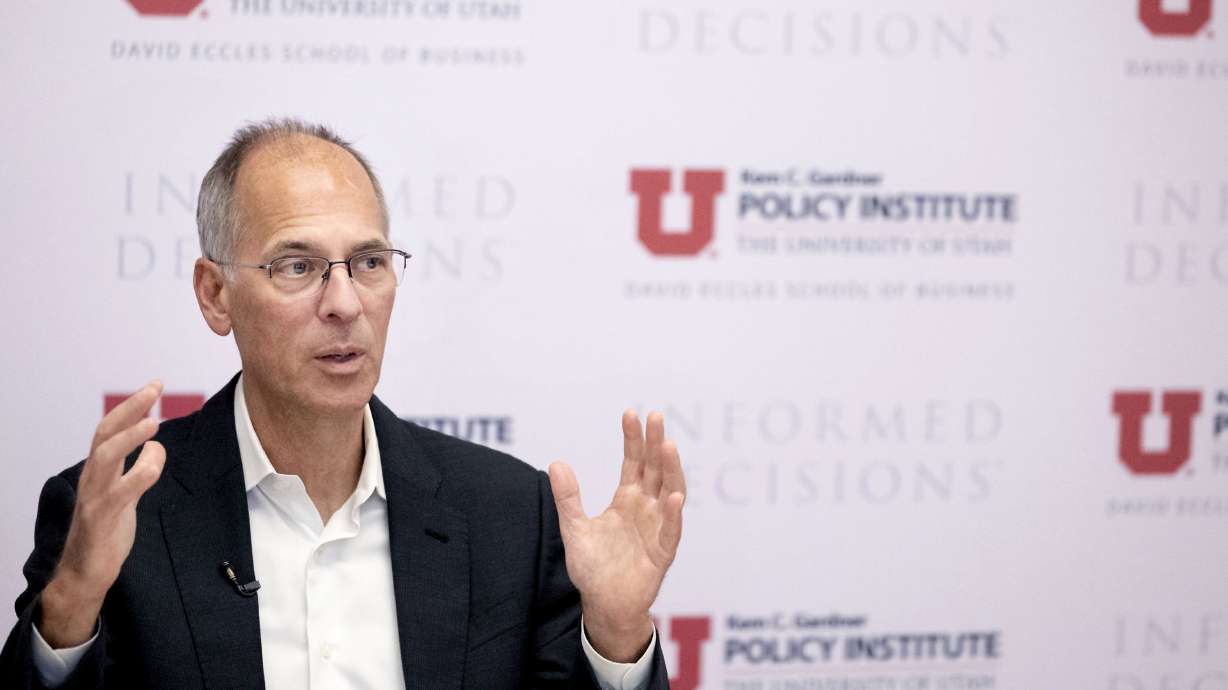SALT LAKE CITY — Mark Zandi, chief economist of Moody’s Analytics, had a less-than-optimistic view when talking about the nation’s economy during his visit to the Beehive State Thursday, describing it as “struggling.”
“You can see the struggle is most evidently in the job market. The job growth that we are getting is very narrowly concentrated, largely in the health care sector and it’s actually growing about as fast as we’ve ever seen it,” Zandi said. “Outside of that, not a lot of jobs.”
Behind this, he said, is a “hiring freeze” across many different industries, which could be attributed to uncertainty created by economic policy around tariffs, immigration policy and other factors.
“We’re not in a recession, but recession risk is still uncomfortably high,” Zandi said, adding that the next year could be “uncomfortable.”
At the state level, the Kem C. Gardner Policy Institute’s chief economist, Phil Dean, said Utah is experiencing “stronger than national economic growth,” but it’s still moderating.
Still, Utah isn’t immune to economic challenges, far from it.
“I do think we have a strong foundation here in Utah. That said, we’re not an island. We’re part of the nation, and we’re going to be connected with what happens at the national level,” Dean said.
Housing is a specific challenge, with Dean noting that Utah has moved from being around the national average in terms of housing costs to being significantly more expensive than the nation as a whole. At the same time, the income of Utah’s families and individuals hasn’t kept pace with housing costs.
National policies impacting Utah
With Dean and Zandi expressing that Utah’s economy is subject to many of the same pressures as the U.S. economy, the conversation shifted to what policies might be driving some of that pressure.
Specifically, Zandi noted stringent immigration policies, which he described as being “very important” in terms of labor supply.
“Immigrants are critical to the workforce in lots of different industries — construction, trades, agriculture, leisure, hospitality, retailing, childcare and that’s become a constraint,” Zandi said. “I’m not a fan of the highly restricted immigration policy. I do think we need to secure our borders. That’s a national security issue, but I think we need immigrants of all skills. We should be working toward a rational immigration policy.”
Zandi added that typically, the U.S. would get about a million immigrants every year, counting both legal and undocumented immigrants. Now, that number is around 200,000 to 300,000.
“That’s not conducive to a well-functioning economy going forward. We need to really rethink that,” Zandi said.
Gardner Institute chief economist Phil Dean, left, and Moody’s Analytics chief economist Mark Zandi speak following a Kem C. Gardner Policy Institute media roundtable at the Thomas S. Monson Center in Salt Lake City on Thursday. (Photo: Laura Seitz, Deseret News)
Another aspect is the reporting blackout of economic data and information, driven by the government shutdown. Zandi said the shutdown and the lack of government data have forced economists across the country to look at alternative data sources.
At the current juncture, he said the lack of data isn’t a serious issue, but if the shutdown drags on — even another week or two — it could become a real problem.
He described the situation using a metaphor of the economy flying an airplane. In his metaphor, the economy is an airplane flying at 30,000 feet and the instrumentation in the plane’s cockpit is economic data.
“In normal times, when the plane is in clear skies at 30,000 feet on autopilot, no big deal. If you get into a thunderstorm, or, you know, there’s no visibility, then you need the instrumentation and if you don’t have it, then you start making bad decisions. Decisions that could actually crash the plane,” Zandi said.
“Right now, we’re at 30,000 feet with clear skies. It’s OK, but who’s to say what the world looks like a week from now, two weeks from now, a month from now — we may be in that thunderstorm. We don’t have the information we need to make decisions and we make a bad decision.”
The Key Takeaways for this article were generated with the assistance of large language models and reviewed by our editorial team. The article, itself, is solely human-written.

